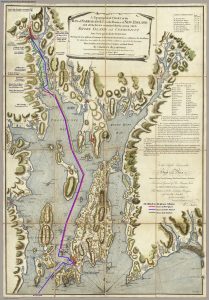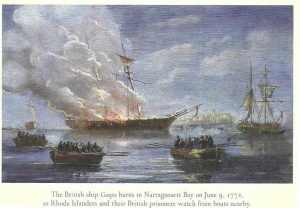From 1690 to 1765, Great Britain and her colonies were involved in 4 wars across 2 continents, putting the mother country heavily in debt in 1763. During this time, King George III ascended to the throne in 1760. Parliament thought the American colonies should help pay for expenses since they had British protection, manufacturing, and citizenship, so they should also be taxed.
The Molasses Act of 1733 made it illegal for British ships to trade for molasses with anyone except British colonies, and put import duties on any illegal trade. The Act was supposed to expire after 30 years, but Parliament revised it to create a new tax called the Sugar Act of 1763. This was a heavier import tax on molasses and other sugars from non-British colonies, and was enforced by British naval vessels. Britain established a court in Nova Scotia that could try and convict anyone without a jury who was suspected of evading the Sugar Act taxes.
Rhode Islanders were outraged about this, because the 1663 Royal Charter allowed them to have the right to establish their own courts and have trial by jury per the English law system. Ships that were caught in RI waters that violated this Act wondered how they could defend themselves in a court convened outside of the RI Charter. Rhode Islanders believed the charter empowered the governor and elected officials to enact laws for benefit of the colony, and they were the only ones to impose taxes on its citizens, not Parliament.
But Parliament didn’t stop with the Sugar Act. It authorized other acts that RI could not appeal because neither they nor the other British colonies had any representation in Parliament. On March 22, 1765, the Stamp Act was passed by the British Parliament. The American Colonies were obliged to pay a fee on almost every piece of paper they used, such as: legal documents, ship’s papers, wills, licenses, newspapers, pamphlets, advertisements, bills of sale, almanacs, calendars, any kind of declarations, pleas to courts, donations, inventory, testimonials, diplomas and certificates of university, college, seminary or academy of learning; affidavits, bails, business licenses, court orders, dice and playing cards among others. People who created public documents had to pay a tax on blank paper they bought. Officials would then place a stamp as proof of payment. The purpose of the collected funds was to protect the American frontier near the Appalachian Mountains. But the majority of the cost was to maintain the contingent of 10,000 British troops in the Colonies.
Two days after the passing of the Stamp Act, the Quartering Act was passed, which required American colonists to house British troops and supply them with food. The next year, Parliament enacted the Declaratory Act where it claimed the right to legislate for the colonies whenever it saw fit – including imposing taxes. Fortunately, the Stamp Act was repealed due to protests on both sides of the Atlantic. But the Rhode Island citizens still believed that the 1663 Charter empowered their own governor and elected officials to enact laws for the benefit of the colony, not Parliament. Nevertheless, in 1767, Parliament passed the Townshend Acts, which imposed duties on tea, glass, lead, paint, and paper. The RI General Assembly petitioned King George III to repeal this act. All the taxes in this act were repealed in 1770 – except for tea.
British ships patrolled Narragansett Bay for tax violators. The first one of these was the Liberty, previously owned by John Hancock and seized by the British in Boston for non-compliance of taxes on its whole cargo. She was burned and destroyed in 1769 by independent Rhode Islanders.
Another such ship was the HMS Gaspee, captained by Lt. William Dudingston. Rhode Islanders did not like him – or his tactics. In addition to stopping and inspecting ocean-going vessels for illegal cargo, he also searched smaller boats ferrying goods from one side of the Bay to the other, suspecting they held illegal goods that had been unloaded before ships entered port.
250 years ago this year, on June 9, 1772, the Gaspee was chasing the sloop Hannah up the Bay.  Fortunately, Hannah’s captain knew the Bay better than Dudingston, so he was able to lure the Gaspee close to shore so she ran aground on Namquit Point southwest of Providence.
Fortunately, Hannah’s captain knew the Bay better than Dudingston, so he was able to lure the Gaspee close to shore so she ran aground on Namquit Point southwest of Providence.
Providence’s leading merchant, John Brown, heard of the grounding of the Gaspee and gathered friends and employees for an attack on the British ship, where the first blood of the Revolution was soon to be shed. What follows next is from a firsthand account of Col. Ephraim Bowen who was there, starting with John Brown’s notification of the Gaspee grounding. The only change I’ve made to this original account is the swearing.
He immediately concluded that she would remain immovable until after midnight, and that now an opportunity offered of putting an end to the trouble and vexation she daily caused. Mr. Brown immediately resolved on her destruction, and he forthwith directed one of his trusty shipmasters to collect eight of the largest long-boats in the harbor, with five oars to each, to have the oars and row-locks well muffled, to prevent noise, and to place them at Fenner’s wharf.
About the time of the shutting up of the shops soon after sunset, a man passed along the Main street beating a drum and informing the inhabitants of the fact, that the Gaspee was aground on Namquit Point, and would not float off until 3 o’clock the next morning, and inviting those persons who felt a disposition to go and destroy that troublesome vessel, to repair in the evening to Mr. James Sabin’s house. About 9 o’clock, I took my father’s gun and my powder horn and bullets and went to Mr. Sabin’s, and found the southeast room full of people, where I loaded my gun, and all remained there till about 10 o’clock, . . . when orders were given to cross the street to Fenner’s wharf and embark; which soon took place, and a sea captain acted as steersman of each boat, of whom I recollect Capt. Abraham Whipple, Capt. John B. Hopkins, (with whom I embarked,) and Capt. Benjamin Dunn. A line from right to left was soon formed, with Capt. Whipple on the right and Capt. Hopkins on the right of the left wing.
The party thus proceeded till within about sixty yards of the Gaspee, when a sentinel hailed, “Who comes there?” No answer. He hailed again and no answer. In about a minute Duddingston mounted the starboard gunwale in his shirt and hailed, “Who comes there?” No answer.
He hailed again, when Capt. Whipple answered as follows — “I am the sheriff of the county of Kent, gosh darn you. I have got a warrant to apprehend you, gosh darn you; so surrender, gosh darn you.” I took my seat on the main thwart, near the larboard row-lock, with my gun by my right side, facing forwards. As soon as Dudingston began to hail, Joseph Bucklin, who was standing on the main thwart by my right side, said to me, “Ephe, reach me your gun and I can kill that fellow.” I reached it to him accordingly, when, during Capt. Whipple’s replying, Bucklin fired and Dudingston fell, and Bucklin exclaimed, “I have killed the rascal.” In less than a minute after Capt. Whipple’s answer, the boats were alongside of the Gaspee, and boarded without opposition. The men on deck retreated below as Dudingston entered the cabin.
As it was discovered that he was wounded, John Mawney, who had for two or three years been studying physic and surgery, was ordered to go into the cabin and dress Dudingston’s wound, and I was directed to assist him. On examination, it was found the ball took effect about five inches directly below the navel. Dudingston called for Mr. Dickinson to produce bandages and other necessaries for the dressing of the wound, and when finished, orders were given to the schooner’s company to collect their clothing and every thing belonging to them and put them into their boats, as all of them were to be sent on shore. All were soon collected and put on board of the boats, including one of our boats. They departed and landed Dudingston at the old still-house wharf, at Pawtuxet, and put the chief into the house of Joseph Rhodes.
Soon after, all the party were ordered to depart, leaving one boat for the leaders of the expedition, who soon set the vessel on fire, which consumed her to the waters’ edge.

Two days later, RI and Providence Plantations Colony Governor Joseph Wanton issued a reward proclamation for 100 pounds for the apprehension of those responsible for the burning of the Gaspee. This was followed by another from King George III on September 2nd to the Governor giving him the authority to discover who was responsible.
Partially because of the fear of reprisals from the burning of the Gaspee, Rhode Island and Virginia started the first Committees of Correspondence in the colonies, an important propaganda tool that would make colonists aware of what was going on and would spread opposition to arbitrary British rule.
[excerpt from Gaspee.org]
